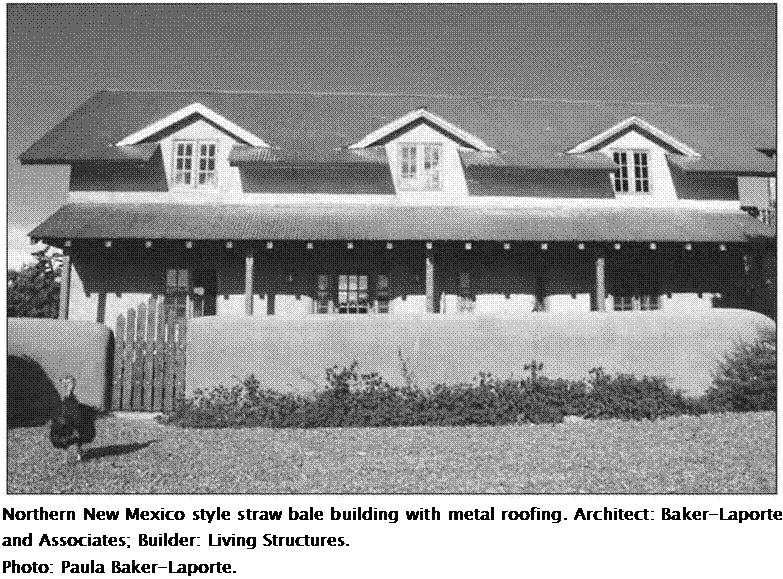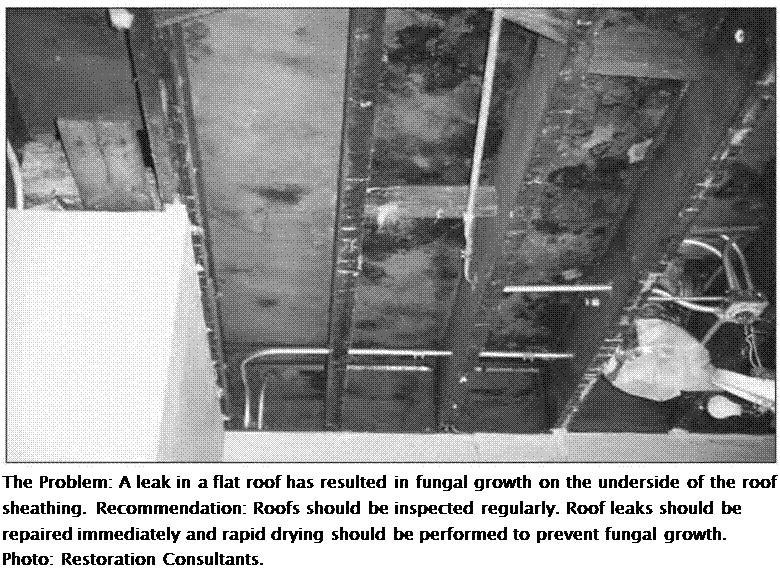Sloped Roofing Materials
Asphalt-based rolled roofing and shingles will outgas when heated by the sun and should be avoided. Clay tile, concrete tile, metal, and slate are all inert, long-lasting slope roof solutions. Wood shingles can be a good roofing material where fire danger is low and humidity is moderate and if rot resistant woods such as cedar are used. Zinc or copper strip applied at the ridge will wash wood shingles with preservatives every time it rains. Availability of roofing materials varies from region to region.
In many cases, roofers will want to install an asphalt-based felt paper over the roof sheathing. Several non-asphaltic-based underlay – ments are now available to choose from:
• RoofShield: High permeability three – layer spun bond polypropylene underlay – ment
• RooftopGuard: Five-layer polypropylene/ polyethylene underlayment
• StrongSeal Roofing Underlayment: Contains no asphalt; both nail-down and selfadhering membranes
• Titanium UDL: Non-asphaltic, coated synthetic roofing underlayment for sloped roofs
 |
Membranes for flat roofing can be problematic. These roofs are in fact more accurately described as having a very low slope, usually Va inch per foot or less. Tile, shingles, and most metal applications that depend on rapid water runoff will not hold up under standing water conditions and are not suitable for low – slope roofs.
Built-up tar and gravel roofing is the most common and least expensive material available for flat roof applications, but we do not recommend it. A tar and gravel roof will emit volatile organic compounds from asphalt, benzene, polycarbon aromatics, toluene, and xylene. It will continually outgas when heated by the sun. Some of these vapors will inevitably find their way into the living space and degrade air quality Eventually the roof will
outgas to the point where it does not adversely affect indoor air quality, but soon thereafter it will require replacement. The average tar and gravel roof is guaranteed for only two to five years and may require replacement in less than 10 years. Since most people are not in a position to move out for several weeks when their roof is repaired or replaced, they will be exposed to high levels of toxic fumes. Chemically sensitive individuals often have difficulty tolerating a tar and gravel roof that is less than one to two years old.
Toxicity is not the only health concern to consider when choosing a product. Many persistent mold infestations begin with an undetected roof leak. No type of roofing installation is foolproof, but the use of high quality roofing materials and skilled installers will reduce the risk of leakage.
 |
Although other solutions are typically more expensive than tar and gravel, you must carefully weigh both lifecycle and health costs when making a roofing choice. Single-ply membranes such as Brai Roof contain asphalt and will also outgas to a certain extent during application when heat is applied to fuse the membrane. Once installed, they are fairly stable. These roofs also carry a longer warranty. Brai Roof can be applied in two ways. It can be mechanically fastened, with seams heat welded together. This is the less odorous method and the one we recommend. It can also be glued down with a layer of hot-mopped tar and seams can be sealed with hot tar. We do not recommend this technique. Certain single-ply membranes can be repaired by welding patches onto the existing roof, thereby extending the roof s life for many years. There are also roll-on roof
ing products that do not require roofing contractors for application or repair.
It is especially important with roofing materials that the manufacturer s instructions for installation and the warranty criteria be carefully followed. Here are some more benign alternatives to tar and gravel roofing for flat – roof applications:
• AFM Safecoat Dynoflex: Low-toxic roof coating to replace tar and gravel that can be walked on and remains flexible
• Brai Roof: An asphaltic-based single-ply membrane (specify mechanical fastening and torch-down application)
• Mirrorseal: A single-ply, fluid-applied roofing system
• Resource Conservation Technologies, Inc.: An acrylic polymer paint or roll-on system that uses titanium dioxide with
propylene glycol and contains no toxic dispersants or tints
• Stevens EP: A heat weldable, scrim reinforced, single-ply roofing membrane made of ethylene propylene
Many solvent-based caulking compounds are formulated with hazardous solvents such as acetone, methyl ethyl acetone, toluene, and xylene. They are toxic to handle and may out – gas for extended periods of time. The following are suggested options for exterior use:
• loo percent silicone aquarium-grade caulk of any brand. Aquarium-grade does not contain any additives that will harm fish and therefore will be safer for humans as well. Be sure to read content labels because some are labeled ‘pure silicone’ but contain other ingredients.
• AFM Safecoat Caulking Compound: Water-based elastic emulsion.
• DAP: loo percent Silicone Sealant or Silicone Plus.
• GE Silicone II: Silicone sealant formulated for different types of application; some may contain biocides.
• Lithoseal Building Caulk: Urethane modified polymer, inert once cured.
• Phenoseal Surpass Caulk and Sealant, Valve Seal, Vinyl Adhesive Caulk: Line of water-based sealants and caulks.
• Weatherall UV Guard Premium Caulking: A professional strength acrylic-based sealant designed for use in a wide variety of construction applications.
Lafavore, Michael. Radon: The Invisible Threat. Rodale Press, 1987.
Lstiburek, Joseph. Builders Guides. Available
through The Energy & Environmental Building Association, 10740 Lyndale Avenue South, Suite 10W, Bloomington, MN 55420,952-881-1098, eeba. org. A series of climate-based field guides with explanations, details, and techniques to effectively implement energy – and resource – efficient residential construction
Lstiburek, Joseph and John Carmody. Moisture Control Handbook: Principles and Practices for Residential and Small Commercial Buildings. Van Nostrand Reinhold, 1993.
US Environmental Protection Agency. A Citizens Guide to Radon. 2nd ed., US Government Printing Office, ЕРА 402-K-92-001, May 1992.
US Environmental Protection Agency. Consumers Guide to Radon Reduction. US Government Printing Office, ЕРА 402-K-92-003, May 1992.
US Environmental Protection Agency. Indoor Radon and Radon Decay Reduction Measurement Device Protocols. US Government Printing Office, EPA 402-R-92-004, July 1992.
US Environmental Protection Agency. Model Standards and Techniques for Control of Radon in New Residential Buildings. US Government Printing Office, EPA 402-R-94-009, March 1994.
US Environmental Protection Agency. Radon Contractor Proficiency (RCP) Program. US Government Printing Office, ЕРА 402-B-94-002, September 1994.






Leave a reply